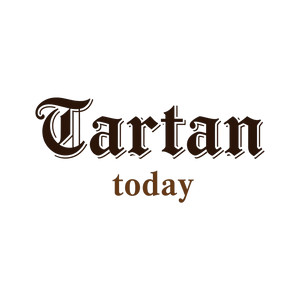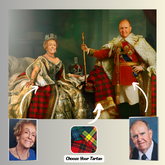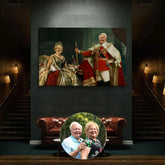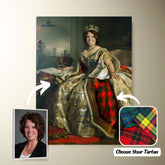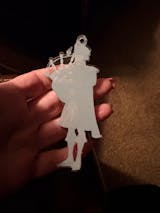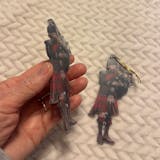-
Personalized Clan Bannatyne 1 Tartan Drummer Ornament with Custom Name – Scottish Christmas Tree Decoration YQ15
Personalized Clan Bannatyne 1 Tartan Drummer Ornament with Custom Name – Scottish Christmas Tree Decoration YQ15Celebrate your Scottish heritage with this unique wood & acrylic tartan ornament. Perfect as a personalized Christmas decoration or a meaningful gift for friends and relatives on special occasions...- From $19.99 USD
$25.99 USD- From $19.99 USD
- Unit price
- per
Save $6.00 -
Personalized Clan Bannatyne 1 Tartan Bagpipe Ornament with Custom Name – Scottish Christmas Tree Decoration RD47
Personalized Clan Bannatyne 1 Tartan Bagpipe Ornament with Custom Name – Scottish Christmas Tree Decoration RD47Celebrate your Scottish heritage with this unique wood & acrylic tartan ornament. Perfect as a personalized Christmas decoration or a meaningful gift for friends and relatives on special occasions...- From $19.99 USD
$25.99 USD- From $19.99 USD
- Unit price
- per
Save $6.00 -
Personalized Clan Bannatyne 1 Tartan Bagpipe Ornament with Custom Name – Scottish Christmas Tree Decoration GJ71
Personalized Clan Bannatyne 1 Tartan Bagpipe Ornament with Custom Name – Scottish Christmas Tree Decoration GJ71Celebrate your Scottish heritage with this unique wood & acrylic tartan ornament. Perfect as a personalized Christmas decoration or a meaningful gift for friends and relatives on special occasions...- From $19.99 USD
$25.99 USD- From $19.99 USD
- Unit price
- per
Save $6.00 -
Custom Name Clan Bannatyne 2 Tartan Garden Flag with Clan Crest and the Golden Sword of Courageous Legacy DW88 - Bannatyne 2
Custom Name Clan Bannatyne 2 Tartan Garden Flag with Clan Crest and the Golden Sword of Courageous Legacy DW88 Immerse your space in the rich heritage of Scotland with our Tartan Garden Flags, exclusively from Tartan Today. Featuring vibrant tartan and Scottish heritage designs, these...- From $34.45 USD
- From $34.45 USD
- Unit price
- per
-
Bannatyne 2
-
Custom Name Clan Bannatyne 1 Tartan Garden Flag with Clan Crest and the Golden Sword of Courageous Legacy LA72 - Bannatyne 1
Custom Name Clan Bannatyne 1 Tartan Garden Flag with Clan Crest and the Golden Sword of Courageous Legacy LA72 Immerse your space in the rich heritage of Scotland with our Tartan Garden Flags, exclusively from Tartan Today. Featuring vibrant tartan and Scottish heritage designs, these...- From $34.45 USD
- From $34.45 USD
- Unit price
- per
-
Bannatyne 1
-
Clan Bannatyne 1 Tartan Scotland Map Canvas “Tartan Runs Through My Veins” Wall Art UG84
Clan Bannatyne 1 Tartan Scotland Map Canvas “Tartan Runs Through My Veins” Wall Art UG84Celebrate your Scottish heritage with this striking canvas print featuring the map of Scotland filled with Bannatyne 1 tartan, paired with the bold phrase: “Tartan Runs Through My Veins.” Whether...- From $35.05 USD
- From $35.05 USD
- Unit price
- per
-
Personalized Clan Bannatyne 1 Tartan Shirt with Scotland Coat of Arms & Custom Name MM64 - Bannatyne 1
Bannatyne 1 Tartan Shirt with Scotland Coat of Arms & Custom Name MM64Celebrate your Scottish heritage with this Bannatyne 1 Tartan Shirt with Scotland Coat of Arms & Custom Name MM64, featuring a bold Scotland Coat of Arms and your custom name on the...- From $39.54 USD
- From $39.54 USD
- Unit price
- per
-
Bannatyne 1
-
Clan Bannatyne 1 Tartan Custom Face Hawaiian Shirt – Unisex Gift for Family Members, Summer Party WP34 - Bannatyne 1 Tartan
Clan Bannatyne 1 Tartan Custom Face Hawaiian Shirt – Unisex Gift for Family Members, Summer Party WP34?? Stand out with our custom face Hawaiian shirt featuring your chosen tartan pattern and up to 10 faces printed for free! Whether it's your own, your pet's,...- $42.25 USD
$59.99 USD- $42.25 USD
- Unit price
- per
Save $17.74-
Bannatyne 1 Tartan
-
Clan Bannatyne 1 Tartan Flat Cap GK14 - Clan Bannatyne 1 Tartan
Clan Bannatyne 1 Tartan Flat Cap GK14Elevate Your Heritage: The Authentic Tartan Jeff Cap Step into a legacy of timeless style and comfort with our Authentic Tartan Flat Cap. Crafted for the discerning American who cherishes their Scottish roots and appreciates classic elegance, this isn’t...- From $33.85 USD
$45.59 USD- From $33.85 USD
- Unit price
- per
Save $11.74-
Clan Bannatyne 1 Tartan
-
Clan Bannatyne Tartan Crest, Badges, Heraldry, Clans, Family Scotland PNG, Digital ClipArt High Quality BT62
Clan Bannatyne Tartan Crest, Badges, Heraldry, Clans, Family Scotland PNG, Digital ClipArt High Quality BT62 DIGITAL FILE ONLY* ** This listing is an INSTANT DIGITAL DOWNLOAD, not a physical item. An instant download is a digital file you can download and use immediately **...- $3.49 USD
$5.99 USD- $3.49 USD
- Unit price
- per
Save $2.50 -
Clan Bannatyne Tartan Polo Shirt Viking Wolf TF77 - Bannatyne Tartan
Clan Bannatyne Tartan Polo Shirt Viking Wolf TF77 Description: Crafted in 100% polyester with your own design which combines comfort and vogue. This shirt has some'great features, it has 3 buttons, elastic collar and cuffs. 12.35 Oz. Made from polyester fabric. 3 buttons, elastic...- $38.25 USD
- $38.25 USD
- Unit price
- per
-
Bannatyne Tartan
-
Clan Bannatyne Tartan Polo Shirt Half of Me - Cross Style ZL42 - Bannatyne Tartan
Clan Bannatyne Tartan Polo Shirt Half of Me - Cross Style ZL42 Description: Crafted in 100% polyester with your own design which combines comfort and vogue. This shirt has some'great features, it has 3 buttons, elastic collar and cuffs. 12.35 Oz. Made from polyester...- $38.25 USD
- $38.25 USD
- Unit price
- per
-
Bannatyne Tartan
-
Clan Bannatyne Tartan Polo Shirt - Royal Coat Of Arms Style GD86 - Bannatyne Tartan
Clan Bannatyne Tartan Polo Shirt - Royal Coat Of Arms Style GD86 Description: Crafted in 100% polyester with your own design which combines comfort and vogue. This shirt has some'great features, it has 3 buttons, elastic collar and cuffs. 12.35 Oz. Made from polyester...- $38.25 USD
- $38.25 USD
- Unit price
- per
-
Bannatyne Tartan
-
Clan Bannatyne Tartan Polo Shirt - Lion Rampant And Celtic Thistle Style ZX53 - Bannatyne Tartan
Clan Bannatyne Tartan Polo Shirt - Lion Rampant And Celtic Thistle Style ZX53 Description: Crafted in 100% polyester with your own design which combines comfort and vogue. This shirt has some'great features, it has 3 buttons, elastic collar and cuffs. 12.35 Oz. Made from...- $38.25 USD
- $38.25 USD
- Unit price
- per
-
Bannatyne Tartan
-
Clan Bannatyne Tartan Polo Shirt - Believe In Me Style RT70 - Bannatyne Tartan
Clan Bannatyne Tartan Polo Shirt - Believe In Me Style RT70 Description: Crafted in 100% polyester with your own design which combines comfort and vogue. This shirt has some'great features, it has 3 buttons, elastic collar and cuffs. 12.35 Oz. Made from polyester fabric....- $38.25 USD
- $38.25 USD
- Unit price
- per
-
Bannatyne Tartan
-
Clan Bannatyne Tartan Polo Shirt - Alba Celtic Style EA54 - Bannatyne Tartan
Clan Bannatyne Tartan Polo Shirt - Alba Celtic Style EA54 Description: Crafted in 100% polyester with your own design which combines comfort and vogue. This shirt has some'great features, it has 3 buttons, elastic collar and cuffs. 12.35 Oz. Made from polyester fabric. 3...- $38.25 USD
- $38.25 USD
- Unit price
- per
-
Bannatyne Tartan
-
Clan Bannatyne Tartan Polo Shirt OP63 - Bannatyne Tartan
Clan Bannatyne Tartan Polo Shirt OP63 Description: Crafted in 100% polyester with your own design which combines comfort and vogue. This shirt has some'great features, it has 3 buttons, elastic collar and cuffs. 12.35 Oz. Made from polyester fabric. 3 buttons, elastic collar and...- $38.25 USD
- $38.25 USD
- Unit price
- per
-
Bannatyne Tartan
-
Clan Bannatyne Clan Unisex Polo Shirt - Celtic Tree Of Life LR19 - Bannatyne Tartan
Clan Bannatyne Clan Unisex Polo Shirt - Celtic Tree Of Life LR19 Description: Crafted in 100% polyester with your own design which combines comfort and vogue. This shirt has some'great features, it has 3 buttons, elastic collar and cuffs. 12.35 Oz. Made from polyester...- $38.25 USD
- $38.25 USD
- Unit price
- per
-
Bannatyne Tartan
-
Clan Bannatyne Clan Polo Shirt Viking Wolf XT64 - Bannatyne
Clan Bannatyne Clan Polo Shirt Viking Wolf XT64 Description: Crafted in 100% polyester with your own design which combines comfort and vogue. This shirt has some'great features, it has 3 buttons, elastic collar and cuffs. 12.35 Oz. Made from polyester fabric. 3 buttons, elastic...- $38.25 USD
- $38.25 USD
- Unit price
- per
-
Bannatyne
-
Clan Bannatyne Clan - Military Polo Shirt LE59 - Bannatyne Tartan
Clan Bannatyne Clan - Military Polo Shirt LE59 Description: Crafted in 100% polyester with your own design which combines comfort and vogue. This shirt has some'great features, it has 3 buttons, elastic collar and cuffs. 12.35 Oz. Made from polyester fabric. 3 buttons, elastic...- $38.25 USD
- $38.25 USD
- Unit price
- per
-
Bannatyne Tartan
Ex: Your Tartan + Product
Popular Products
Turn Me Royal Personalized Portrait from Your Photo, Custom Tartan. Custom Canvas Wall Art as Gift for Men
- From $32.45 USD
- From $32.45 USD
- Unit price
- / per
Royalty Couple Personalized Portrait from Your Photo, Custom Tartan. Custom Canvas Wall Art
- From $47.45 USD
- From $47.45 USD
- Unit price
- / per
The Queen Personalized Portrait from Your Photo, Custom Tartan. Custom Canvas Wall Art as Gift for Women
- From $32.45 USD
- From $32.45 USD
- Unit price
- / per
Which Clan Are You From?
List Of Tartan
-
Clan A
- Abercrombie Tartan
- Aberdeen Tartan
- Abernethy Tartan
- Adair Tartan
- Adam Tartan
- Ayrshire Tartan
- Agnew Tartan
- Aikenhead Tartan
- Ainslie Tartan
- Aiton Tartan
- Allan Tartan
- Alexander Tartan
- Allardice Tartan
- Allison Tartan
- Anderson Tartan
- Angus Tartan
- Anstruther Tartan
- Arbuthnot Tartan
- Armstrong Tartan
- Arnott Tartan
- Auchinleck Tartan
- Ayrshire Tartan
-
Clan B
- Baillie Tartan
- Bain Tartan
- Baird Tartan
- Balfour Tartan
- Bannatyne Tartan
- Bannerman Tartan
- Barclay Tartan
- Baxter Tartan
- Beaton Tartan
- Bell Tartan
- Belshes Tartan
- Bethune Tartan
- Beveridge Tartan
- Binning Tartan
- Bisset Tartan
- Blackadder Tartan
- Blackstock Tartan
- Black Watch Tartan
- Blair Tartan
- Blane Tartan
- Blyth Tartan
- Borthwick Tartan
- Boswell Tartan
- Bowie Tartan
- Boyd Tartan
- Boyle Tartan
- Brisbane Tartan
- Brodie Tartan
- Brown/ Broun Tartan
- Bruce Tartan
- Buccleuch Tartan
- Buchan Tartan
- Buchanan Tartan
- Burnett Tartan
- Burns Tartan
- Butter Tartan
- Byres Tartan
-
Clan C
- Cairns Tartan
- Calder Tartan
- Callander Tartan
- Cameron Tartan
- Campbell Tartan
- Campbell of Breadalbane Tartan
- Campbell of Cawdor Tartan
- Carmichael Tartan
- Carnegie Tartan
- Carruthers Tartan
- Cathcart Tartan
- Chalmers Tartan
- Charteris Tartan
- Chattan Tartan
- Cheyne Tartan
- Chisholm Tartan
- Christie Tartan
- Clark Tartan
- Clelland Tartan
- Clephan Tartan
- Clergy Tartan
- Cochrane Tartan
- Cockburn Tartan
- Colquhoun Tartan
- Colville Tartan
- Cooper Tartan
- Couper Tartan
- Craig Tartan
- Cranstoun Tartan
- Crawford Tartan
- Crichton Tartan
- Crief District Tartan
- Crosbie Tartan
- Cumming Tartan
- Cunningham Tartan
- Currie Tartan
- Clan D
- Clan E
- Clan F
- Clan G
- Clan H
- Clan I
- Clan J
- Clan K
- Clan L
-
Clan M
- Maitland Tartan
- Malcolm Tartan
- Mar Tartan
- Marjoribanks Tartan
- Maxtone Tartan
- Matheson Tartan
- Maule Tartan
- Maxwell Tartan
- Meldrum Tartan
- Melville Tartan
- Menzies Tartan
- Mercer Tartan
- Middleton Tartan
- Moffat Tartan
- Moncrieffe Tartan
- Montgomery Tartan
- Monypenny Tartan
- Moncreiffe Tartan
- Monteith Tartan
- Morrison Tartan
- Mouat Tartan
- Moubray Tartan
- Mow Tartan
- Muir_More Tartan
- Muirhead Tartan
- Munro Tartan
- Murray Tartan
- Murray of Atholl Tartan
-
Clan Mc/Mac
- MacAlister Tartan
- MacArthur Tartan
- MacAlpine Tartan
- MacAulay Tartan
- MacBain Tartan
- MacBean Tartan
- MacBeth Tartan
- MacCallum Tartan
- MacCraig Tartan
- MacColl Tartan
- MacCorquodale Tartan
- MacDiarmid Tartan
- MacDonald Tartan
- MacDonald of Clanranald Tartan
- MacDonald of Sleat Tartan
- MacDonnell of Glengarry Tartan
- MacDonnell of Keppoch Tartan
- MacDougall Tartan
- MacDowall Tartan
- MacDuff Tartan
- MacEwen_MacEwan Tartan
- MacEdward Tartan
- MacFarlane Tartan
- MacGill Tartan
- MacGillivray Tartan
- MacGregor Tartan
- MacGowan (McGowan) Tartan
- MacHardy Tartan
- MacIan Tartan
- MacInnes Tartan
- MacIntyre Tartan
- MacKay Tartan
- MacKillop Tartan
- MacKellar Tartan
- Mackinlay Tartan
- MacKenzie Tartan
- Mackie Tartan
- MacKinnon Tartan
- MacKintosh / MacIntosh Tartan
- MacLeod Tartan
- MacMillan Tartan
- MacNab Tartan
- MacNaughton Tartan
- MacNeil / MacNeill Tartan
- MacNeil of Colonsay Tartan
- MacNicol Tartan
- MacPhail Tartan
- MacPhee_MacFie Tartan
- MacPherson Tartan
- MacQuarrie Tartan
- MacQueen Tartan
- MacRae Tartan
- MacRow Tartan
- MacSporran Tartan
- MacTaggart Tartan
- MacTavish Tartan
- MacThomas Tartan
- McCorquodale Tartan
- McCulloch Tartan
- McFadzen Tartan
- McGeachie Tartan
- McIver Tartan
- McKerrell Tartan
- Clan N
- Clan O
- Clan P
- Clan R
-
Clan S
- Sandilands Tartan
- Scott Tartan
- Scrymgeour Tartan
- Selkirk Tartan
- Sempill Tartan
- Seton Tartan
- Shaw Tartan
- Shepherd Tartan
- Sinclair Tartan
- Skene Tartan
- Skirving Tartan
- Smith Tartan
- Somerville Tartan
- Spalding Tartan
- Spens Tartan
- Spottiswood Tartan
- Stevenson Tartan
- Stewart Tartan
- Stewart of Appin Tartan
- Stirling Tartan
- Strachan Tartan
- Straiton Tartan
- Strange Tartan
- Strathclyde District Tartan
- Stuart of Bute Tartan
- Sutherland Tartan
- Swinton Tartan
- Clan T
- Clan U W Y
- Request Your Clan
Clan Bannatyne (Bannatyne Tartan)
1. About Clan Bannatyne (Bannatyne Tartan)
2. Clan Bannatyne History (Bannatyne Tartan)
Bannatynes had two main branches: the Bute (and subsequently Arran) Bannatynes (Kames) and the Larnarkshire (Corhouse) Bannatynes. These two branches' connection may not be evident. It's best to approach them as distinct families.
Clan Campbell has a sept known as the Bute Bannatynes.
Although the precise site of this is unknown, it is said that the place name Bennachtain is the source of the name Bannatyne. Benachtyne and Bannachtyne, among other variations, were two ways to spell the name.
Numerous medieval manuscripts include the earliest mentions of this name. A William de Bennothine, who saw a bequest by David Olifard to the Hospital of Soltre between 1153 and 1177, is one of the earliest instances.
William of Moravia signed a charter in favor of the same hospital between 1278 and 1294, and Nicolas de Benthyne was present.
The thriving Sir Richard of Bannochtine of the Corhouse, whose son is known as Sir John Bannatyne, occasionally signed himself as "Bannachty." Charles II used this spelling throughout his reign.
2.1 Bannatyne of Kames
Walter the High Steward awarded Gilbert, son of Gilbert, a charter in 1318 for the use of one archer in the army and attendance at three courts in Bute.
Gilbert was the owner of the threepenny lands of Kylmacolmac in the centre of the island. Cainys, who is now Kames, was taken possession of by the Bannatynes. On the Cowal peninsula in Argyll and Bute, there is a little village called Kames.
Alexander III's tenure saw the rise of Gilbert Bannatyne of Kames, whose grandson John Bannatyne served as laird and keeper of Rothesay Castle for the Stewarts in 1334.
Before Rothesay had a Town Council and before it was a Royal Burgh, the Bannatynes were likely the town's rulers and governors.
There is no written documentation to support the widely held claim that Robert the Bruce gave the Bannatynes the land in exchange for their service at Bannockburn.
Nevertheless, the Bannatynes were a wealthy family that enjoyed great favor with the aristocracy. This can be observed in Port Bannatyne, a village three miles away from Rothesay.
The Bannatynes can be identified as being in possession of Kames by charters and bonds of man rent as early as the fourteenth century, when it is assumed that Kames castle, a single tower that was long the family's residence, was built.
Gilbert, the son of Gilbert, acquired Kames Castle through a charter from King Alexander III, bringing it into the family. Bannatyne of Kames served as the leader of the Bute Bannatynes.
2.2 Spence and Bannatyne Feud
The estates of Kames and Wester Kames divided the land, dividing it between them at times and passing it occasionally from one to the other.
Spens of Wester Kames, Bannatyne of Kames, and the Stuarts of Bute were the three most significant and influential landowners.
Hector Bannatyne of Kames, who signed the National Covenant on behalf of the Bute landlords, and Matthew Spence, who signed it on behalf of the Rothesay landowners, were also signatories.
Many human bones were discovered mixed in with stones when an earthen tumulus (mound) was demolished to make room for a road.
One of the Spences of Wester Kames, who was killed in a battle with the Bannatynes of Easter Kames, is said to have been buried here, according to tradition. On the place, he was interred, and a cairn was built over him.
In 1547, the then-head of the family and Stuart of Bute committed to supporting one another against all enemies, with the exception of the King and the Earl of Argyll.
This came after Bannatyne tied himself to the Earl in a Manrent Bond in 1538.
Bannatyne had trouble getting some of his Cowal tenants to pay their rent, so two days later he traveled to Auchincrossan in Cowal with two other Bannatynes and one of the Spences as witnesses.
He gave the tenants the option of paying the past-due rent or quitting. They paid him no mind. He returned six weeks later and removed three pieces of furniture from each home, but the tenants refused to budge.
Then he went back and drove all of their livestock away by himself. Young Lamont of Inveryne gave the tenants encouragement as they drove the laird's cattle away and continued driving their own.
Bannatyne was so furious that he confided in Argyle that he was failing to provide the promised support. Argyle then issued an appearance notice for Inveryne in Dunoon court, and the Kyle sheriff was given the case.
Although there is no written record of the court's decisions, it is likely that Bannatyne won because the family is known to have owned the disputed estates from before 1475 until 1623.
They thereafter appear to have loyally followed the Campbell Chiefs, with Bannatyne of Kames serving as a Campbell chieftain in all but name, from that point forward.
The Bannatynes of Bute and later of Arran are the only Bannatynes with a Campbell connection. Different Bannatynes have different links.
Arran presently has a larger population of Bannatynes than Bute.
2.3 Bannatynes of Corhouse
This Bannatynes branch is thought to be the oldest. The Bannatynes of Cainys, now Kames, in the Island of Bute, and of Kelly, founded by a second son of same line, were descended from the former.
James Bannatyne of Newhall, son of the laird of Newtyle, Forfarshire, was named a lord of session on February 14, 1626; he died in 1636.
Corra Castle
The Bannatyne Family constructed Corra Castle, a fortified farmstead, in the fifteenth century. The Corehouse Estate currently owns it.
It is unknown if the Bonnytin estate in Ayrshire has any ties to the Bannatyne family.
In the eighteenth century, the Ballantynes of Peebles rose to prominence in the Scottish wool trade, and in 1829, they played a key role in the growth of the Scottish tweed industry.
Possible connection to the Earls of Lennox
The title "Chief of the MacAmelynes" that Bond Bannatyne is given in the 1547 Bond is a bungled attempt by a scribe to give him but one that sounds far more Gaelic in nature and may indicate the genuine origin of this kindred.
Amhalghaidh, sometimes pronounced Aulay, is a potential derivation of this name. Allan of Faslane's great-grandfather was the son of Alwin, 2nd Earl of Lennox, who had a son by the same name.
Prior to 1672, Bannatyne of Kames's coat of arms was gules with a chevron of argent between three mullets of or. At first glance, there doesn't appear to be any link to the Earls of Lennox's arms (argent, a saltire between four roses gules), although a Bannatyne has occasionally employed the argent, a chevron between four mullets gules.
A chevron is obviously the bottom portion of a saltire, and Lecky of that ilk, whose progenitor was also a son of Alwyn, 2nd Earl of Lennox (argent, a chevron between three roses gules), employed it.
Although mullets (five-pointed stars) are not roses, the entire shield may appear to have a connection to a heraldic eye. It could be worthwhile to look for a connection between the Earls of Lennox and the Bannatynes of Kames.
3. Clan Bannatyne Tartans
Bannatyne does not have a recognised tartan, but being a sept of Clan Campbell, they are permitted to don the Campbell tartans.
Campbell Ancient
Campbell Dress
Campbell Modern
Campbell Weathered
4. Clan Bannatyne Crest & Coats of Arms
4.1 Clan Bannatyne Crest
Worn by all of the name and ancestry
4.2 Clan Bannatyne Coats of Arms
Note on Coats of Arms: A coat of arms is given to an individual under Scottish heraldic law (with the exception of civic or corporate arms).
A 'family coat of arms' does not exist. With the exclusions listed above, the weapons depicted below are personal weapons. The only person authorized to use these weapons is the grantee.
5. Clan Bannatyne Places & People
5.1 Clan Bannatyne Places
Built in the 1500s, Corra Castle in Lanarkshire was formerly a Bannatyne stronghold. The castle is currently deserted and in ruins.
5.2 Clan Bannatyne People
5.2.1 George Bannatyne (1545–1608)
Scottish-born merchant and burgess well renowned for his collection of Scottish poetry. He was born in Angus.
He put together an amazing collection of contemporaneous Scots poetry from his day that was eight hundred folio pages long and was divided into five parts.
One of the most important collections of Middle Scots literature is thought to be the Bannatyne Manuscript. It includes a number of pieces by Alexander Scott, Henryson, Dunbar, Lyndsay, and Montgomerie.
The National Library of Scotland now holds it.
5.2.2 Richard Bannatyne (died 1605)
Scottish cleric and scribe who assisted John Knox as his secretary.
5.2.3 Sir William Macleod Bannatyne FRSE (1743–1833)
Advocate, jurist, antiquarian, and historian from Scotland. Son of Hector Bannatyne of Kames and Isabel, daughter of Roderick Macleod. After Lord Swinton's death in 1765, he was elevated to the bench and made an advocate.
He later succeeded to his mother's lands on the Isle of Bute to become Lord Bannatyne. On the island near Port Bannatyne, he was in charge of significantly expanding Kames Castle, which he later sold to the Hamiltons in 1812.
After relocating to Edinburgh, Bernadine passed away in the Canongate's Whiteford House. Veterans in their golden years now reside in the structure.
7. Clan Bannatyne: A Unique Armigerous Clan of Scottish Heritage
Clan Bannatyne holds a unique place in Scottish history, known for its armigerous status and connections to the influential Clan Campbell.
This article will explore the origins and meaning of the Bannatyne name, the symbolism behind its crest and motto, the historic seats of the clan, and its relevance to Scottish heritage.
We will also answer frequently asked questions about Clan Bannatyne, including its motto, surviving members, association with the Campbell tartan, the fate of its historic castles, and the possibility of joining Clan Campbell for individuals with the Bannatyne surname. Let's dive into the rich history and significance of Clan Bannatyne.
8. The Origins and Meaning of the Bannatyne Name
The Bannatyne name traces its roots to the placename Bennachtain, which continues to be shrouded in mystery. Scholars have yet to discover the exact location or meaning of Bennachtain, adding an air of intrigue to the origin of the Bannatyne name.
However, through historical records, it is believed that the Bannatynes are descendants of the powerful Clan Campbell.
9. The Crest and Motto of Clan Bannatyne
The crest of Clan Bannatyne features a demi-griffin holding a sword, symbolizing strength and courage. This emblem represents the clan's proud heritage and its willingness to defend its values.
The motto "Nec Cito Nec Tarde," meaning "Neither Fast Nor Slow," reflects the clan's approach to life, emphasizing the importance of balance and measured action in all endeavors.
10. The Historic Seats of Clan Bannatyne
Corra Castle, located in Scotland, serves as an important seat of Clan Bannatyne.
This ancient fortress not only provides a glimpse into the clan's influence and presence in the region but also serves as a testament to their storied history.
Additionally, Kames Castle on the Isle of Bute stands as a notable seat, further highlighting the impact of Clan Bannatyne in Scottish heritage.
11. Armigerous Status and Absence of Recognized Chief
Clan Bannatyne holds the distinction of being an armigerous clan, meaning it lacks an officially recognized chief.
Despite this absence, the clan's connection to the Campbells of Bute and Arran strengthens their ties to the larger Clan Campbell.
Through shared heritage and ancestry, the Bannatynes maintain their place within the broader Campbell clan structure.
12. The Association with the Campbell Tartan
While there is no registered Bannatyne Tartan, Clan Bannatyne embraces the Campbell tartan as a symbol of their identity and heritage.
The Campbell tartan is renowned for its rich history, and its use by Clan Bannatyne further solidifies the connection between the two clans.
Wearing the Campbell tartan allows Bannatyne descendants to proudly display their shared ancestry.
13. Exploring the History of Clan Bannatyne
The historical records pertaining to Clan Bannatyne are limited, adding to the enigmatic nature of the clan.
Despite this scarcity of information, the clan's history holds immense importance in understanding the broader story of Scottish heritage.
The connection between Clan Bannatyne and Clan Campbell offers invaluable insights into the political and cultural landscape of Scotland.
14. Clan Bannatyne's Relevance to Scottish Heritage
Clan Bannatyne's contribution to Scottish heritage cannot be overstated.
By preserving the clan's history, individuals with Bannatyne ancestry ensure that future generations understand and appreciate their unique heritage.
Recognizing and upholding the legacy of Clan Bannatyne is essential in maintaining the rich tapestry of Scottish culture and heritage.
15. Frequently Asked Questions about Clan Bannatyne
15.1 What is the significance of Clan Bannatyne's motto?
The motto "Nec Cito Nec Tarde" holds deep meaning for Clan Bannatyne. It represents the clan's approach to life, emphasizing the importance of balance and measured action.
This motto serves as a guiding principle in daily life and decision-making, reminding clan members to act deliberately and with purpose.
15.2 Are there any surviving members of Clan Bannatyne?
Given the armigerous status of Clan Bannatyne, there are no current clan members in the traditional sense.
However, individuals with Bannatyne ancestry can still preserve and honor their historical ties and heritage, ensuring that the legacy of Clan Bannatyne continues to be appreciated and celebrated.
15.3 Why is the Campbell tartan associated with Clan Bannatyne?
The association between the Campbell tartan and Clan Bannatyne stems from the historical connection between the two clans.
Clan Bannatyne has embraced the Campbell tartan as a symbol of their shared heritage and ancestry.
Wearing the Campbell tartan allows Bannatyne descendants to proudly display their connection to the larger Clan Campbell.
15.4 What happened to Corra Castle and Kames Castle?
Corra Castle, an important seat of Clan Bannatyne, currently stands in ruins, serving as a reminder of the clan's storied past. Kames Castle, located on the Isle of Bute, also holds historical significance for Clan Bannatyne.
Efforts are underway to preserve these castles and their historical value for future generations to appreciate.
15.5 Can someone with the Bannatyne surname join Clan Campbell?
Individuals with the Bannatyne surname can find recognition and acceptance within the larger Clan Campbell structure.
The connection between Clan Bannatyne and Clan Campbell allows individuals with Bannatyne ancestry to join and participate in the activities and traditions of Clan Campbell, forging bonds with their shared heritage.
16. Conclusion
Clan Bannatyne stands as a unique armigerous clan with deep ties to Scottish heritage. Through its association with Clan Campbell, the significance of the Bannatyne name, the symbolism of its crest and motto, and the history of its historic seats, Clan Bannatyne showcases the rich tapestry of Scottish culture and ancestry.
Preserving the legacy of Clan Bannatyne ensures that future generations can appreciate and celebrate their unique heritage, carrying forward the traditions and values of this remarkable clan.
- Choosing a selection results in a full page refresh.
